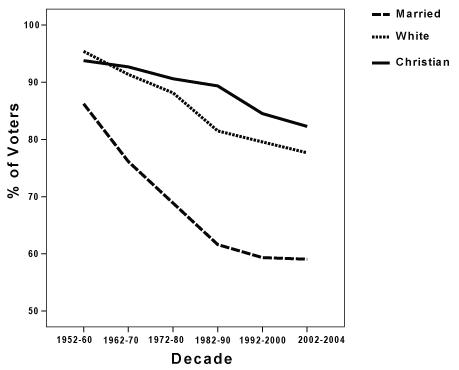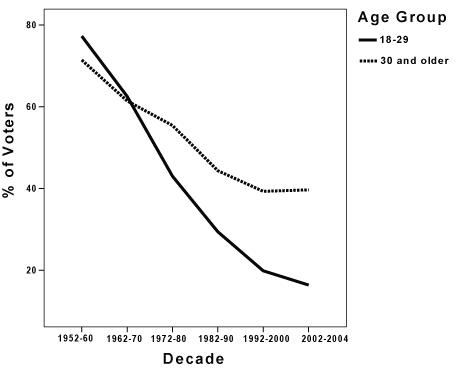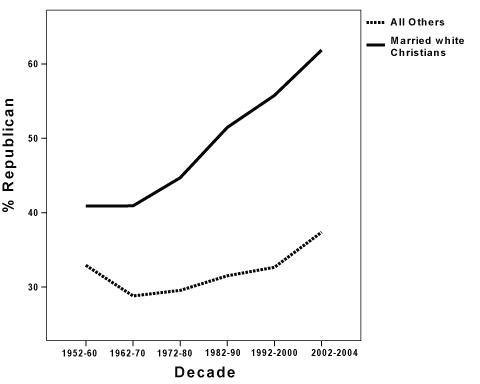The Incredible Shrinking Republican Base
A Commentary by Alan Abramowitz
Discussions of the current political situation and comparisons between the 2008 election and earlier contests frequently overlook a crucial fact. As a result of changes in American society, today's electorate is very different from the electorate of twenty, thirty, or forty years ago. Three long-term trends have been especially significant in this regard: increasing racial diversity, declining rates of marriage, and changes in religious beliefs. As a result of these trends, today's voters are less likely to be white, less likely to be married, and less likely to consider themselves Christians than voters of just a few decades ago.
The combined impact of these trends on the composition of the electorate has been dramatic. Married white Christians now make up less than half of all voters in the United States and less than one fifth of voters under the age of 30. The declining proportion of married white Christians in the electorate has important political implications because in recent years married white Christians have been among the most loyal supporters of the Republican Party. In American politics today, whether you are a married white Christian is a much stronger predictor of your political preferences than your gender or your class -- the two demographic characteristics that dominate much of the debate on contemporary American politics.
Figure 1 displays the trends in the proportions of whites, married persons, and Christian identifiers in the U.S. electorate over the past half century according to data from the American National Election Studies. Between the middle of the 20th century and the beginning of the 21st century, the proportion of whites has fallen by about 15 percentage points, the proportion of married persons has fallen by about 25 percentage points, and the proportion of Christian identifiers has fallen by about 10 percentage points.
Figure 1. The Changing Social Characteristics of the American Electorate: Race, Religion, and Marital Status since the 1950s
Source: NES Cumulative File.
Married individuals still make up a large majority of the electorate, whites are still close to 80 percent of the electorate, and Christians are still over 80 percent of the electorate. However, the combined impact of the changes illustrated in Figure 1 has been enormous. Married white Christians have gone from close to 80 percent of the electorate in the 1950s to just over 40 percent of the electorate in the first decade of the 21st century. Moreover, the data displayed in Figure 2 show that the decline in married white Christians has been even more drastic among younger Americans. The proportion of married white Christians among voters under the age of 30 has plummeted from almost 80 percent in the 1950s to less than 20 percent in the first decade of the 21st century.
Figure 2. The Decline of Married, White Christians in the U.S. Electorate since the 1950s
Source: NES Cumulative File.
These changes in the social composition of the American electorate are politically significant because married white Christians now constitute the core of the Republican electoral coalition. Not only are married white Christians more likely to support the GOP than other Americans, but, as the data displayed in Figure 3 show, the gap between these two groups has widened from less than 10 percentage points in the 1950s to 25 percentage points in the first decade of the 21st century.
Figure 3. A Growing Gap: Republican Identification among Married White Christians and Other Voters since the 1950s
Source: NES Cumulative File.
Even though married white Christians have been shrinking as a proportion of the American electorate, the Republican Party has been able to maintain and even slightly increase its share of the electorate since the 1960s by steadily increasing its support among married white Christians. The data in Figure 3 show that between the 1950s and the first decade of the 21st century, Republican identification among married white Christians increased by more than 20 percentage points, going from about 40 percent to over 60 percent. However, the ability of the GOP to continue to offset the diminishing size of its married white Christian base by making further gains among this group is questionable. Republican gains among married white Christians have occurred almost entirely among self-identified conservatives. Between the 1970s and the first decade of the 21st century, Republican identification among conservative married white Christians increased by 26 points, going from 64 percent to 90 percent, according to NES data. During the same time period, Republican identification among moderate married white Christians increased by only five points, going from 38 percent to 43 percent and Republican identification among liberal married white Christians actually declined by 10 points, falling from 23 percent to 13 percent. These results suggest that the potential for additional Republican gains among married white Christians may be limited. Conservative married white Christians already overwhelmingly identify with the GOP and the party has had little success in increasing its support among moderate-to-liberal married white Christians.
The danger posed to the Republican Party by the declining size of its married white Christian base was clearly illustrated by the results of the 2006 midterm election. According to the 2006 national exit poll, married white Christians made up just under half of the midterm electorate and they voted for Republican House candidates over Democratic House candidates by a decisive 62 to 38 percent margin. However, voters who were not married white Christians made up just over half of the electorate and they voted for Democratic House candidates over Republican House candidates by an even more decisive 68 to 32 percent margin. The result was a big win for the Democrats in the midterm election.
In addition to the large gains made by Democrats in the House and Senate elections, another striking feature of the 2006 results was the presence of a fairly large generation gap within the electorate. As the data displayed in Table 1 show, voters under the age of 30 were considerably more likely to identify with the Democratic Party and vote for Democratic candidates than older voters. While the youth vote was not solely responsible for the Democratic victory in 2006, the party's 22 point advantage among voters under the age of 30 clearly contributed to the magnitude of that victory.
Table 1. The Generation Gap in 2006
|
Age Group |
||||
|
18 - 29 |
30 - 59 |
60 + |
||
|
Party Identification |
||||
|
Democratic |
43% |
37% |
36% |
|
|
Independent |
26% |
27% |
27% |
|
|
Republican |
31% |
36% |
37% |
|
|
House Vote |
||||
|
Democratic |
61% |
54% |
51% |
|
|
Republican |
39% |
46% |
49% |
|
Source: 2006 National Exit Poll.
An important question about the generation gap in the 2006 election is whether it was based mainly on short-term factors such as discontent with the war in Iraq, or whether it reflected long-term trends in the demographic make-up of the American electorate. We have already seen that the decline in the proportion of married white Christians since the 1950s has been much more dramatic among younger voters than among older voters and the results of this long-term trend were clearly reflected in the social characteristics of the 2006 electorate. According to the national exit poll data, only 17 percent of voters under the age of 30 were married white Christians compared with just over half of older voters.
Table 2. Explaining the Generation Gap in Political Attitudes and Behavior
|
Married, White Christians |
All Others |
|||||
|
18 - 29 |
30 + |
18 - 29 |
30 + |
|||
|
Party Identification |
||||||
|
Democratic |
26% |
26% |
47% |
49% |
||
|
Independent |
22% |
24% |
28% |
28% |
||
|
Republican |
53% |
49% |
26% |
23% |
||
|
House Vote |
||||||
|
Democratic |
33% |
38% |
68% |
68% |
||
|
Republican |
67% |
62% |
32% |
32% |
||
Source: 2006 National Exit Poll.
In order to determine whether long-term demographic changes were responsible for the generation gap in voting behavior, I compared the preferences of younger and older voters in the 2006 House elections while controlling for their demographic characteristics. The results displayed in Table 2 show that married white Christians under the age of 30 were just as likely to vote for a Republican House candidate as married white Christians over the age of 30. Similarly, voters over the age of 30 who were not married white Christians were just as likely to vote for a Democratic House candidate as voters under the age of 30 who were not married white Christians. Thus, the current generation gap in voting behavior appears to be completely explained by the difference between the proportions of married white Christians in these two groups. The reason that voters under the age of 30 are now significantly more Democratic than older voters is that they are much less likely to be married, white, and Christian.
In addition to age, two other demographic characteristics that have received a great deal of attention in commentary on the 2008 election are gender and class. In recent weeks there has been endless speculation about the relative abilities of Barack Obama and Hillary Clinton to appeal to two groups whose support is widely considered to be critical to Democratic chances in November: lower income whites and white women. The assumption here is that class and gender play important roles in shaping voter preferences in the contemporary electorate. However, the evidence from the 2006 national exit poll shows that whether someone was a married white Christian was a much stronger predictor of his or her political preferences than either gender or class.
Table 3. Percentage Voting for Democratic House Candidate in 2006 by Income and Gender among Married White Christians and Others
|
Married, White Christians |
Others |
||
|
Gender |
|||
|
Male |
36% |
67% |
|
|
Female |
39% |
68% |
|
|
Family Income |
|||
|
Under $30K |
45% |
72% |
|
|
$30-$50K |
36% |
70% |
|
|
$50-$75K |
41% |
63% |
|
|
$75-$100K |
39% |
63% |
|
|
$100-$150K |
36% |
66% |
|
|
Over $150K |
31% |
72% |
|
Source: 2006 National Exit Poll.
According to the evidence displayed in Table 3, after controlling for whether or not a voter was a married white Christian, neither gender nor income had much influence on voters' preferences. Women who were married white Christians voted overwhelmingly for Republican candidates and men who were not married white Christians voted overwhelmingly for Democratic candidates. Similarly, lower income individuals who were married white Christians voted overwhelmingly for Republican candidates and upper income individuals who were not married white Christians voted overwhelmingly for Democratic candidates.
The decline in the proportion of married white Christians in the American electorate has been going on for a long time. Moreover, the large generational difference in the prevalence of married white Christians in the contemporary electorate suggests that this trend is likely to continue for the foreseeable future. What cannot be predicted as confidently is how party leaders will respond to this trend. Right now, Democrats appear likely to benefit from a continued decline in the proportion of married white Christians in the electorate because this group has strongly supported Republican candidates in recent elections while voters who are not married white Christians have strongly supported Democratic candidates.
Since the potential for additional Republican gains among married white Christians appears to be limited, Republican leaders will need to find ways to reduce the Democratic advantage among voters who are not married white Christians in order to maintain the party's competitive position. However, given the generally liberal views of this group, this will not be easy. In 2006, according to data from the Cooperative Congressional Election Study, 57 percent of these voters supported a woman's right to choose an abortion under any circumstances, 66 percent opposed a constitutional amendment to prohibit gay marriage, and 71 percent favored a single-payer health care system. Any attempt by Republican leaders to significantly increase their party's support among voters who are not married white Christians would therefore require changes in some of the party's longstanding policy commitments -- changes that would clearly upset a large segment of the current Republican base.
Dr, Alan Abramowitz is the Alben W. Barkely Professor of Political Science at Emory University, and the author of Voice of the People: Elections and Voting Behavior in the United States
See Other Commentary by Dr. Alan Abramowitz
Rasmussen Reports is a media company specializing in the collection, publication and distribution of public opinion information.
We conduct public opinion polls on a variety of topics to inform our audience on events in the news and other topics of interest. To ensure editorial control and independence, we pay for the polls ourselves and generate revenue through the sale of subscriptions, sponsorships, and advertising. Nightly polling on politics, business and lifestyle topics provides the content to update the Rasmussen Reports web site many times each day. If it's in the news, it's in our polls. Additionally, the data drives a daily update newsletter and various media outlets across the country.
Some information, including the Rasmussen Reports daily Presidential Tracking Poll and commentaries are available for free to the general public. Subscriptions are available for $4.95 a month or 34.95 a year that provide subscribers with exclusive access to more than 20 stories per week on upcoming elections, consumer confidence, and issues that affect us all. For those who are really into the numbers, Platinum Members can review demographic crosstabs and a full history of our data.
To learn more about our methodology, click here.



